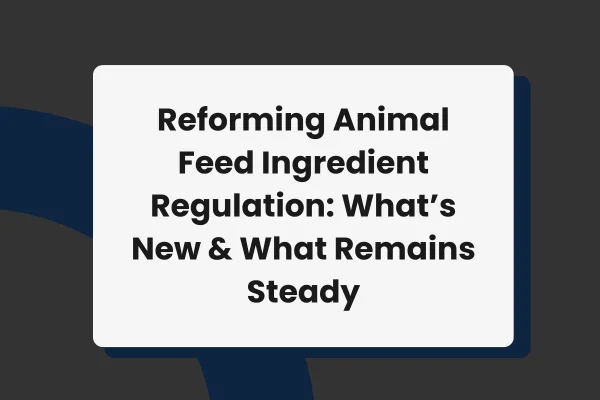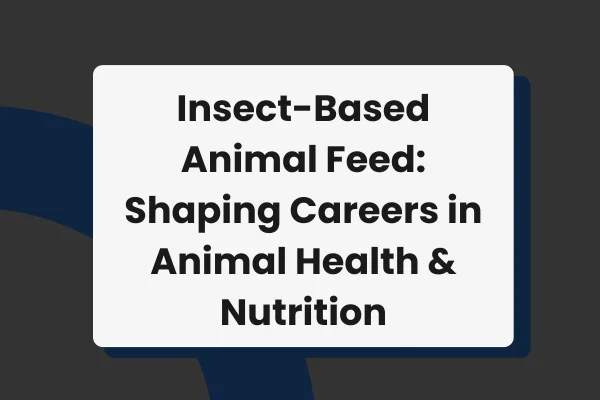Animal feed ingredient regulation is a critical foundation for safety, innovation, and predictable industry operations. Recent reforms in the United States represent one of the most significant regulatory shifts in decades. These changes affect ingredient review processes, definitions, and engagement with regulatory agencies. For recruitment specialists and industry employers, understanding these reforms is essential, as regulatory complexity directly influences the types of skills, expertise, and talent required in the animal health and nutrition sector.
The Traditional Regulatory Framework
Historically, the review of feed ingredients followed structured pathways. The Food Additive Petition (FAP) process was the main federal route for approval, requiring extensive safety and utility data submitted to the FDA. Ingredients could also be recognised as “generally recognised as safe” (GRAS), allowing certain substances to enter the market without formal rulemaking.
AAFCO definitions, created under a Memorandum of Understanding (MOU) with the FDA, provided additional clarity and allowed ingredients to be legally marketed at the state level. These systems created predictable timelines and compliance expectations, shaping the hiring needs of companies in regulatory affairs, scientific evaluation, and compliance monitoring.
Why Reform Has Industry and Talent Implications
The traditional system faced increasing pressure from the rise of novel ingredients, functional claims, and complex formulations. Review timelines were extended, creating uncertainty for companies. Regulatory shifts, including the termination of the FDA–AAFCO MOU in 2023, removed formal federal backing for AAFCO definitions.
For recruitment experts, this change signals new talent priorities. Companies now require professionals who can navigate evolving frameworks, assess the appropriate regulatory pathways for new ingredients, and ensure compliance with both federal and state requirements. Roles in regulatory affairs, scientific evaluation, and project management are increasingly strategic rather than purely operational.
Emerging Regulatory Pathways
Animal Food Ingredient Consultation (AFIC)
AFIC provides a structured, consultative pathway with the FDA. Companies can engage in dialogue during ingredient review, aiming for clear safety conclusions while following rigorous scientific standards. Employers now seek candidates who understand AFIC protocols and can manage these consultations effectively, bridging regulatory science and commercial strategy.
Scientific Review of Ingredient Submissions (SRIS)
SRIS establishes independent expert panels to evaluate ingredient submissions, producing scientifically credible definitions. While FDA concurrence is not involved, state regulators may accept SRIS-reviewed ingredients. Recruitment in this area increasingly demands professionals who can coordinate with expert panels, translate scientific assessments into actionable business decisions, and monitor state-level compliance implications.
GRAS and Self-GRAS
GRAS remains a viable pathway, but scrutiny of self-GRAS determinations is increasing. Talent capable of interpreting GRAS data, evaluating safety dossiers, and anticipating regulatory changes is now critical for companies aiming to bring products to market efficiently.
What Remains Steady
Safety continues to be the non-negotiable requirement for all feed ingredients. Scientific data supporting intended use and safety remains essential, and state feed laws continue to govern ingredient marketing within jurisdictions. While federal review pathways are changing, the principles guiding regulatory compliance have not.
From a recruitment perspective, this means that expertise in safety assessment, regulatory documentation, and compliance project management remains highly valuable. Employers are looking for individuals who combine regulatory knowledge with the ability to adapt to emerging pathways like AFIC and SRIS.
Challenges and Recruitment Considerations
The evolving regulatory environment introduces challenges that affect workforce planning. FDA and AAFCO must build capacity to manage AFIC and SRIS submissions efficiently. Variability in state acceptance and potential changes to self-GRAS policies can create uncertainty.
For hiring managers, this means prioritising professionals with adaptability, cross-functional communication skills, and experience in regulatory strategy. Companies may also need to strengthen internal training and knowledge-sharing processes to ensure teams remain aligned with ongoing regulatory reforms.
Strategic Implications for Employers and Job Seekers
For ingredient manufacturers and feed producers, choosing the right regulatory pathway is a strategic decision. Companies must assess ingredient type, claims, and market objectives to determine whether AFIC, SRIS, or GRAS is the most appropriate route. Talent that can navigate these decisions and support efficient submission processes is increasingly in demand.
For job seekers, expertise in regulatory affairs, feed science, and compliance strategy is a differentiator. Professionals who understand the nuances of emerging review pathways and can support safe and timely ingredient approvals are well-positioned for roles in R&D, regulatory teams, and compliance management.
Outlook
The reform of animal feed ingredient regulation represents a period of adjustment for the industry. AFIC is operational, SRIS is being established, and GRAS policy continues to evolve. Stakeholders who stay informed, engage proactively with regulators, and invest in skilled talent will be better positioned to bring innovative and compliant products to market.
For recruitment specialists and hiring managers, this period underscores the importance of attracting and retaining professionals with regulatory expertise, scientific insight, and strategic thinking. Talent will continue to play a central role in how the animal health and nutrition sector adapts to these regulatory reforms.
Reforms in animal feed ingredient regulation are reshaping review pathways, introducing new mechanisms like AFIC and SRIS, while maintaining core principles of safety and state oversight. These changes have direct implications for recruitment and talent strategies in the animal health and nutrition industry. Companies that align hiring priorities with regulatory demands and emerging pathways will be best positioned to navigate this evolving landscape successfully.
For further insights on talent and industry developments, visit our Animal Health and Nutrition page.





